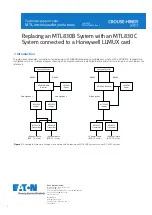
Troubleshooting
2-6
5. After repairing the instrument, start again at step 1
to check the integrity of the repair and to see if
there are any other failures.
2.5.1 AUTOMATIC Testing
1. Display the MAIN MENU by pressing the MENU
key.
2. Use the
or
key to place the cursor on TEST
and press ENTER to display the SELF-TEST
MENU.
3. Place the cursor on BUILT-IN-TEST and press EN-
TER to display the following menu:
BUILT-IN TEST
AUTOMATIC
MANUAL
4. Place the cursor on AUTOMATIC and press EN-
TER. The following prompt is displayed:
CONTINUOUS REPEAT?
NO
YES
In the non-repeat mode (NO), the testing process
stops after all tests have been performed one time.
In the continuous repeat mode (YES), the testing
process loops around and repeats indeÞnitely until
the EXIT key is pressed to stop the tests.
5. Place the cursor on the desired repeat mode selec-
tion (NO or YES) and press ENTER to start the test-
ing process. The instrument displays the number
of the test being run. An ÒAÓ on the display indi-
cates that the tests are being run automatically in
the non-repeat mode. An ÒACÓ indicates that the
tests are being run automatically in the continuous
repeat mode. If a failure occurs, a star (*) appears at
the right hand end of the display and remains on
for the remainder of the tests.
6. If the non-repeat mode is selected, the testing pro-
cess automatically stops when all the tests have
been performed. If the continuous repeat mode is
selected, you will have to manually stop the testing
process by pressing EXIT. When EXIT is pressed,
all the tests in a series already started will be al-
lowed to Þnish.
When the testing process stops, the following mes-
sage is displayed:
All tests complete *
Press ENTER to review or EXIT
The star (*) is only displayed if a failure occurs.
7. If all the tests passed (no star displayed), use the
EXIT key to back out of the menu structure. Other-
wise, press ENTER to display the test number of
the Þrst failure. You can display any additional fail-
ures by using the
and
keys. With a failed test
displayed, pressing the INFO key provides an ab-
breviated description of the failure. Paragraph 2.10
provides detailed documentation for troubleshoot-
ing the defective circuit. When Þnished, use EXIT
to back out of the menu structure.
2.5.2 MANUAL Testing
1. Display the MAIN MENU by pressing the MENU
key.
2. Use the
or
key to place the cursor on TEST
and press ENTER to display the SELF-TEST
MENU.
3. Place the cursor on BUILT-IN-TEST and press EN-
TER to display the following menu:
BUILT-IN TEST
AUTOMATIC
MANUAL
4. Place the cursor on MANUAL and press ENTER to
display the currently selected test series number.
Test number: 100
This test number indicates that the 100 series tests
can be performed. In this case there is only one test;
test 100.1.
5. Use the
or
to display the desired test series
number. For example, if you wish to run test 200.5,
display the series 200 test number.
Test number: 200
6. With the desired test series number displayed,
press ENTER. The following menu displayed:
SELECT LOOPING
SINGLE
CONTINUOUS
STEP
7. Place the cursor on the desired looping selection
and press ENTER.
A. SINGLE Looping performs all the tests in the
speciÞed series. The instrument displays the
number of the test being run, and an ÒMÓ is dis-
Содержание 2001
Страница 1: ...Model 2001 Multimeter Repair Manual Contains Servicing Information...
Страница 129: ...Troubleshooting 2 116...
Страница 139: ...Replaceable Parts 4 4...
Страница 149: ...Replaceable Parts 4 14...
Страница 153: ...Replaceable Parts 4 18...
Страница 156: ...A Model 2001 Specifications A 1...
















































